Auditing Report: Business Risk Assessment of Stockland Stapled Company
VerifiedAdded on 2019/11/08
|17
|4107
|342
Report
AI Summary
This report provides a comprehensive auditing analysis of Stockland Stapled, a major real estate company. It begins with an executive summary and table of contents, followed by an introduction outlining the report's focus on business risk assessment. The report then delves into the nature of Stockland Stapled, including its history, business segments, and financial performance. It examines the real estate industry in Australia, including its contribution to GDP, growth rate, key players, and growth opportunities. The legal environment section covers intellectual property, business and environmental laws, import/export regulations, and financial reporting standards. External environmental factors are analyzed using PEST, SWOT, and Porter's Five Forces models. The report assesses the company's objectives, strategies, and business risks. It includes sections on analytical procedures and management/governance, concluding with a summary of findings and a list of references. The analysis covers various aspects such as market competition, supplier bargaining power, buyer dynamics, and the impact of interest rates, providing a detailed overview of the company's operational and strategic environment.

Auditing 1
Running Head: Auditing
Auditing
Running Head: Auditing
Auditing
Paraphrase This Document
Need a fresh take? Get an instant paraphrase of this document with our AI Paraphraser
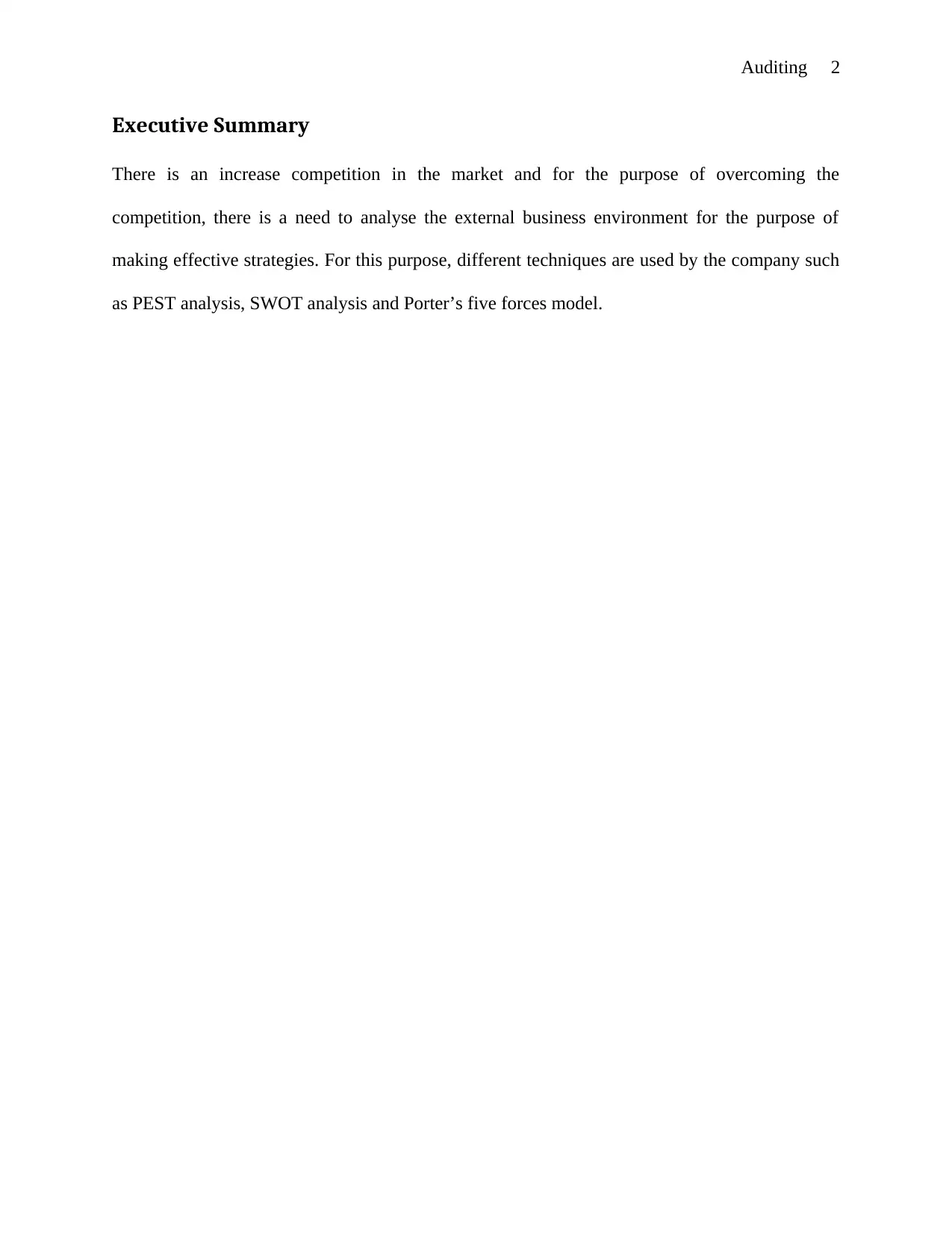
Auditing 2
Executive Summary
There is an increase competition in the market and for the purpose of overcoming the
competition, there is a need to analyse the external business environment for the purpose of
making effective strategies. For this purpose, different techniques are used by the company such
as PEST analysis, SWOT analysis and Porter’s five forces model.
Executive Summary
There is an increase competition in the market and for the purpose of overcoming the
competition, there is a need to analyse the external business environment for the purpose of
making effective strategies. For this purpose, different techniques are used by the company such
as PEST analysis, SWOT analysis and Porter’s five forces model.

Auditing 3
Table of Contents
Executive Summary.......................................................................................................................................2
Introduction....................................................................................................................................................3
Part 1: Understanding Nature of the Entity....................................................................................................4
Part 2: Understanding the Industry................................................................................................................4
Part 3: Understanding the legal environment:...............................................................................................5
Part 4: Understanding External Environmental Factors................................................................................7
Part 5: Understand objectives, strategies and Assessing Business Risks:...................................................11
Part 6 Performing Analytical Procedures to understand Entity’s Performance...........................................12
Part 7: Understand management and Governance:......................................................................................14
Conclusion...................................................................................................................................................15
References....................................................................................................................................................16
Table of Contents
Executive Summary.......................................................................................................................................2
Introduction....................................................................................................................................................3
Part 1: Understanding Nature of the Entity....................................................................................................4
Part 2: Understanding the Industry................................................................................................................4
Part 3: Understanding the legal environment:...............................................................................................5
Part 4: Understanding External Environmental Factors................................................................................7
Part 5: Understand objectives, strategies and Assessing Business Risks:...................................................11
Part 6 Performing Analytical Procedures to understand Entity’s Performance...........................................12
Part 7: Understand management and Governance:......................................................................................14
Conclusion...................................................................................................................................................15
References....................................................................................................................................................16
⊘ This is a preview!⊘
Do you want full access?
Subscribe today to unlock all pages.

Trusted by 1+ million students worldwide
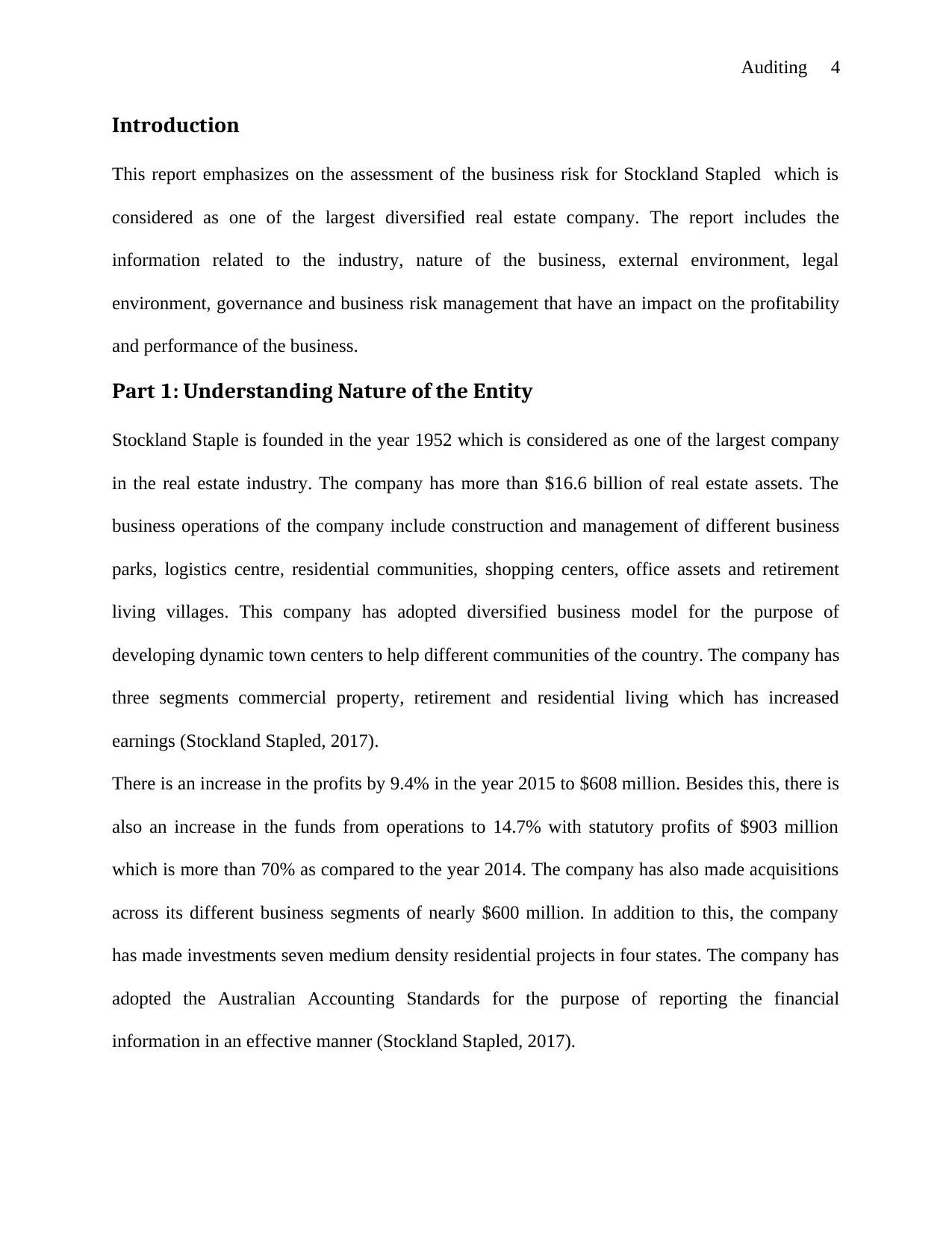
Auditing 4
Introduction
This report emphasizes on the assessment of the business risk for Stockland Stapled which is
considered as one of the largest diversified real estate company. The report includes the
information related to the industry, nature of the business, external environment, legal
environment, governance and business risk management that have an impact on the profitability
and performance of the business.
Part 1: Understanding Nature of the Entity
Stockland Staple is founded in the year 1952 which is considered as one of the largest company
in the real estate industry. The company has more than $16.6 billion of real estate assets. The
business operations of the company include construction and management of different business
parks, logistics centre, residential communities, shopping centers, office assets and retirement
living villages. This company has adopted diversified business model for the purpose of
developing dynamic town centers to help different communities of the country. The company has
three segments commercial property, retirement and residential living which has increased
earnings (Stockland Stapled, 2017).
There is an increase in the profits by 9.4% in the year 2015 to $608 million. Besides this, there is
also an increase in the funds from operations to 14.7% with statutory profits of $903 million
which is more than 70% as compared to the year 2014. The company has also made acquisitions
across its different business segments of nearly $600 million. In addition to this, the company
has made investments seven medium density residential projects in four states. The company has
adopted the Australian Accounting Standards for the purpose of reporting the financial
information in an effective manner (Stockland Stapled, 2017).
Introduction
This report emphasizes on the assessment of the business risk for Stockland Stapled which is
considered as one of the largest diversified real estate company. The report includes the
information related to the industry, nature of the business, external environment, legal
environment, governance and business risk management that have an impact on the profitability
and performance of the business.
Part 1: Understanding Nature of the Entity
Stockland Staple is founded in the year 1952 which is considered as one of the largest company
in the real estate industry. The company has more than $16.6 billion of real estate assets. The
business operations of the company include construction and management of different business
parks, logistics centre, residential communities, shopping centers, office assets and retirement
living villages. This company has adopted diversified business model for the purpose of
developing dynamic town centers to help different communities of the country. The company has
three segments commercial property, retirement and residential living which has increased
earnings (Stockland Stapled, 2017).
There is an increase in the profits by 9.4% in the year 2015 to $608 million. Besides this, there is
also an increase in the funds from operations to 14.7% with statutory profits of $903 million
which is more than 70% as compared to the year 2014. The company has also made acquisitions
across its different business segments of nearly $600 million. In addition to this, the company
has made investments seven medium density residential projects in four states. The company has
adopted the Australian Accounting Standards for the purpose of reporting the financial
information in an effective manner (Stockland Stapled, 2017).
Paraphrase This Document
Need a fresh take? Get an instant paraphrase of this document with our AI Paraphraser

Auditing 5
Part 2: Understanding the Industry
The real estate industry contributes 18% of the total GDP of the Australia. The growth rate of the
real estate industry is 4.2% annually. The real estate companies focuses on procurement an
element of the supply chain in order to create effective portfolio strategy by the analysis of
delivery, monitoring of the procurement activities in a timely manner. The stakeholder
management is done by engaging with suppliers and customers by the way of consultation,
communication, negotiation and reporting. The procurement function can be improved by the
implementation of the effective administration policies. The real estate industry provides
employment to approximately 110132 employees. The size of the real estate investment market
has grown to $ 7.4 trillion in 2016 from $7.1 trillion in 2015 (Forlee, 2015).
The major players in the real estate industry in Australia include Richardson &Wrench, LJ
Hooker, Barry Plant, Harcourts Group, Mirvac Ltd and Elders Real Estate. These players has
different growth opportunities and provide luxurious services to the customers due to presence of
various factors such as lifestyle, demographics, job creation, population growth, infrastructure
and amenity. There is an increase in the population of the Australia which has resulted in
increasing the demand for residential properties and different businesses which provide different
growth opportunities to the real estate companies. In addition to this, it also helps in attracting
large number of investors which results in increasing the number of competitors in the market
(Jones & Rogers, 2016).
Part 3: Understanding the legal environment:
Understanding the Australian legal obligations is very important for every business. These legal
obligations designed by the Australian government to establish fair competition between
Part 2: Understanding the Industry
The real estate industry contributes 18% of the total GDP of the Australia. The growth rate of the
real estate industry is 4.2% annually. The real estate companies focuses on procurement an
element of the supply chain in order to create effective portfolio strategy by the analysis of
delivery, monitoring of the procurement activities in a timely manner. The stakeholder
management is done by engaging with suppliers and customers by the way of consultation,
communication, negotiation and reporting. The procurement function can be improved by the
implementation of the effective administration policies. The real estate industry provides
employment to approximately 110132 employees. The size of the real estate investment market
has grown to $ 7.4 trillion in 2016 from $7.1 trillion in 2015 (Forlee, 2015).
The major players in the real estate industry in Australia include Richardson &Wrench, LJ
Hooker, Barry Plant, Harcourts Group, Mirvac Ltd and Elders Real Estate. These players has
different growth opportunities and provide luxurious services to the customers due to presence of
various factors such as lifestyle, demographics, job creation, population growth, infrastructure
and amenity. There is an increase in the population of the Australia which has resulted in
increasing the demand for residential properties and different businesses which provide different
growth opportunities to the real estate companies. In addition to this, it also helps in attracting
large number of investors which results in increasing the number of competitors in the market
(Jones & Rogers, 2016).
Part 3: Understanding the legal environment:
Understanding the Australian legal obligations is very important for every business. These legal
obligations designed by the Australian government to establish fair competition between

Auditing 6
competitors, to provide protection to parties and integrity in the market. The regulations that
should be following by the businesses in Australia are discussed below:
Intellectual property laws:
Intellectual property includes patent, trademarks, design and secret processes and formulas of
business. Australian intellectual property law has legal obligations about the patent of a
company. Patent is an exclusive right provided by government to an inventor and according to
these rights no third party can make and use that invention (Hart, et al., 2013). Along with this,
businesses can register a trademark and in some circumstances it works as a marketing tool.
When a company registers its trademark than other companies cannot use the brand of registered
company.
Australian business and environment laws:
Australian government has made some regulations to protect the consumers, the environment of
Australia and the community of the country, as well as these regulations made to promote fair
trading and fair competition. To ensure fair trading with businesses and consumers Australia has
a national statutory framework. For unfair contract terms, consumer right guarantee, product
safety laws and other areas, Australian government made Australian Consumer law (ACL). This
law should be follow by the businesses for a fair trading (Latimer, 2012). According to this law
if any business does not follow this law than that business will be punishable.
Australian Import and Export Law:
Australia has strong business contracts with most of the other countries. The Australian
government has number of policies that assist Australian businesses to involve in international
trade. Australia has six Free Trade Agreements (FTAs) with other countries. Businesses in
Australia can import goods from other countries but that import functions should be done under
competitors, to provide protection to parties and integrity in the market. The regulations that
should be following by the businesses in Australia are discussed below:
Intellectual property laws:
Intellectual property includes patent, trademarks, design and secret processes and formulas of
business. Australian intellectual property law has legal obligations about the patent of a
company. Patent is an exclusive right provided by government to an inventor and according to
these rights no third party can make and use that invention (Hart, et al., 2013). Along with this,
businesses can register a trademark and in some circumstances it works as a marketing tool.
When a company registers its trademark than other companies cannot use the brand of registered
company.
Australian business and environment laws:
Australian government has made some regulations to protect the consumers, the environment of
Australia and the community of the country, as well as these regulations made to promote fair
trading and fair competition. To ensure fair trading with businesses and consumers Australia has
a national statutory framework. For unfair contract terms, consumer right guarantee, product
safety laws and other areas, Australian government made Australian Consumer law (ACL). This
law should be follow by the businesses for a fair trading (Latimer, 2012). According to this law
if any business does not follow this law than that business will be punishable.
Australian Import and Export Law:
Australia has strong business contracts with most of the other countries. The Australian
government has number of policies that assist Australian businesses to involve in international
trade. Australia has six Free Trade Agreements (FTAs) with other countries. Businesses in
Australia can import goods from other countries but that import functions should be done under
⊘ This is a preview!⊘
Do you want full access?
Subscribe today to unlock all pages.

Trusted by 1+ million students worldwide
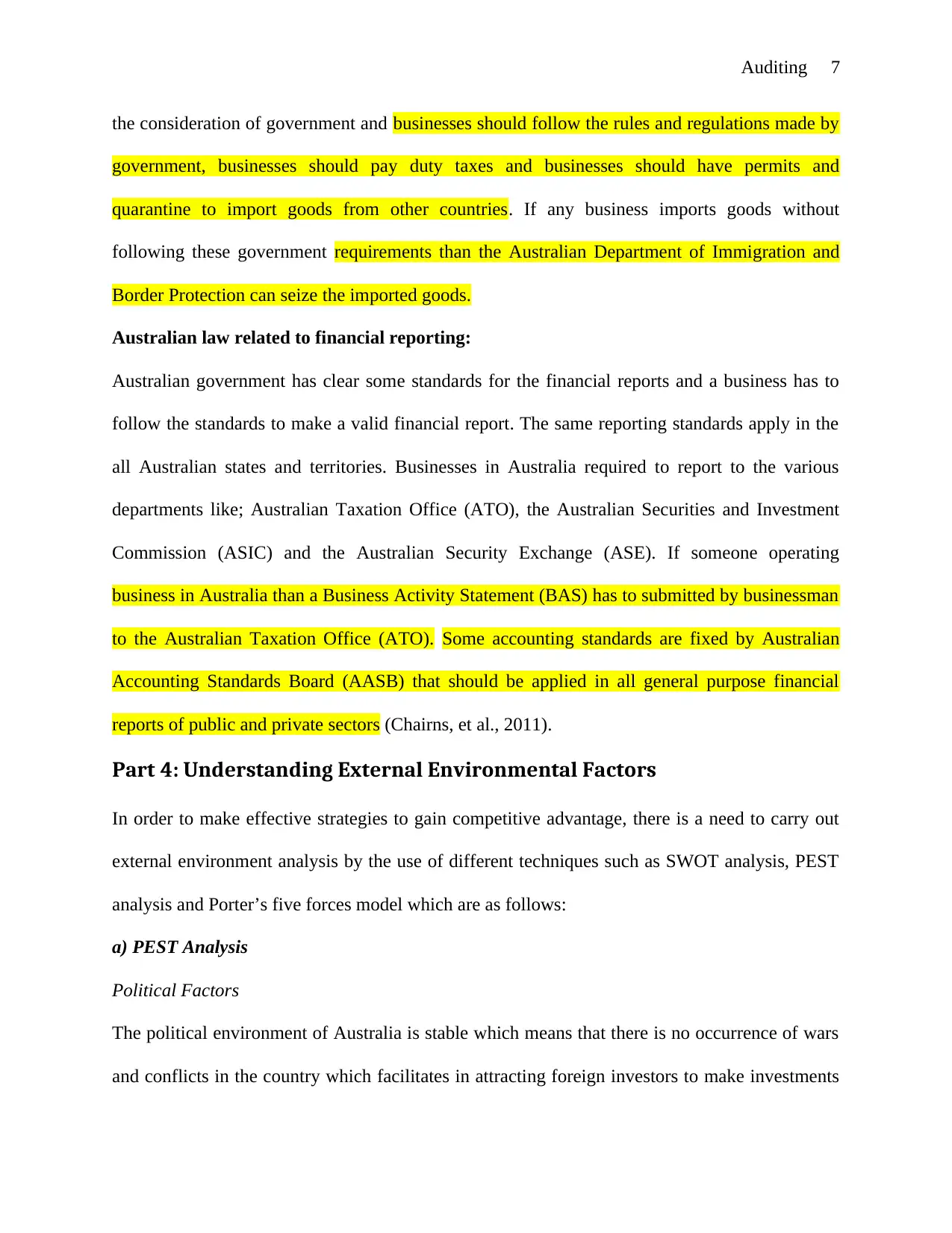
Auditing 7
the consideration of government and businesses should follow the rules and regulations made by
government, businesses should pay duty taxes and businesses should have permits and
quarantine to import goods from other countries. If any business imports goods without
following these government requirements than the Australian Department of Immigration and
Border Protection can seize the imported goods.
Australian law related to financial reporting:
Australian government has clear some standards for the financial reports and a business has to
follow the standards to make a valid financial report. The same reporting standards apply in the
all Australian states and territories. Businesses in Australia required to report to the various
departments like; Australian Taxation Office (ATO), the Australian Securities and Investment
Commission (ASIC) and the Australian Security Exchange (ASE). If someone operating
business in Australia than a Business Activity Statement (BAS) has to submitted by businessman
to the Australian Taxation Office (ATO). Some accounting standards are fixed by Australian
Accounting Standards Board (AASB) that should be applied in all general purpose financial
reports of public and private sectors (Chairns, et al., 2011).
Part 4: Understanding External Environmental Factors
In order to make effective strategies to gain competitive advantage, there is a need to carry out
external environment analysis by the use of different techniques such as SWOT analysis, PEST
analysis and Porter’s five forces model which are as follows:
a) PEST Analysis
Political Factors
The political environment of Australia is stable which means that there is no occurrence of wars
and conflicts in the country which facilitates in attracting foreign investors to make investments
the consideration of government and businesses should follow the rules and regulations made by
government, businesses should pay duty taxes and businesses should have permits and
quarantine to import goods from other countries. If any business imports goods without
following these government requirements than the Australian Department of Immigration and
Border Protection can seize the imported goods.
Australian law related to financial reporting:
Australian government has clear some standards for the financial reports and a business has to
follow the standards to make a valid financial report. The same reporting standards apply in the
all Australian states and territories. Businesses in Australia required to report to the various
departments like; Australian Taxation Office (ATO), the Australian Securities and Investment
Commission (ASIC) and the Australian Security Exchange (ASE). If someone operating
business in Australia than a Business Activity Statement (BAS) has to submitted by businessman
to the Australian Taxation Office (ATO). Some accounting standards are fixed by Australian
Accounting Standards Board (AASB) that should be applied in all general purpose financial
reports of public and private sectors (Chairns, et al., 2011).
Part 4: Understanding External Environmental Factors
In order to make effective strategies to gain competitive advantage, there is a need to carry out
external environment analysis by the use of different techniques such as SWOT analysis, PEST
analysis and Porter’s five forces model which are as follows:
a) PEST Analysis
Political Factors
The political environment of Australia is stable which means that there is no occurrence of wars
and conflicts in the country which facilitates in attracting foreign investors to make investments
Paraphrase This Document
Need a fresh take? Get an instant paraphrase of this document with our AI Paraphraser

Auditing 8
in different companies of different industries. In addition to this, the country has liberalized
trading policies which results in promotion of the businesses in the real estate industry as the
investors are attracted to make investment in the industry. Besides this, it also facilitates in
expansion of the real estate businesses with lower risks (Frynas & Mellahi, 2015).
Economic Factors
The GDP and employment growth rate of Australia is declined which has a significant impact on
the lifestyle of the people in the country. In addition to this, declined economic growth of the
company is considered unfavorable for the businesses. The presence of competitive interest rate
and tax rate is considered favorable for the Stockland Stapled company as it facilitates in gaining
finance at low cost for carrying out their activities and expansion of the business operations
(Pimentel & Peshin, 2014).
Social Factors
There is an increase in the population of the country due to increase in the number of immigrants
from different countries for the purpose of gaining education and labor for different businesses.
This has resulted in increased demand for different types of properties in the country such as
residential properties, business outlets and so on. This is considered favorable for the Stockland
Stapled company and results in accelerating the growth of the company in the country (Posner,
2014).
Technological factors:
Rapid changes have been taking place in the technologies, therefore, it is required by the
companies to adopt new technologies to construct properties in the country to develop
infrastructure which helps in attracting investors and businesses to make investment in the
country which results in increasing the standard of living of the people in the country. Stockland
in different companies of different industries. In addition to this, the country has liberalized
trading policies which results in promotion of the businesses in the real estate industry as the
investors are attracted to make investment in the industry. Besides this, it also facilitates in
expansion of the real estate businesses with lower risks (Frynas & Mellahi, 2015).
Economic Factors
The GDP and employment growth rate of Australia is declined which has a significant impact on
the lifestyle of the people in the country. In addition to this, declined economic growth of the
company is considered unfavorable for the businesses. The presence of competitive interest rate
and tax rate is considered favorable for the Stockland Stapled company as it facilitates in gaining
finance at low cost for carrying out their activities and expansion of the business operations
(Pimentel & Peshin, 2014).
Social Factors
There is an increase in the population of the country due to increase in the number of immigrants
from different countries for the purpose of gaining education and labor for different businesses.
This has resulted in increased demand for different types of properties in the country such as
residential properties, business outlets and so on. This is considered favorable for the Stockland
Stapled company and results in accelerating the growth of the company in the country (Posner,
2014).
Technological factors:
Rapid changes have been taking place in the technologies, therefore, it is required by the
companies to adopt new technologies to construct properties in the country to develop
infrastructure which helps in attracting investors and businesses to make investment in the
country which results in increasing the standard of living of the people in the country. Stockland
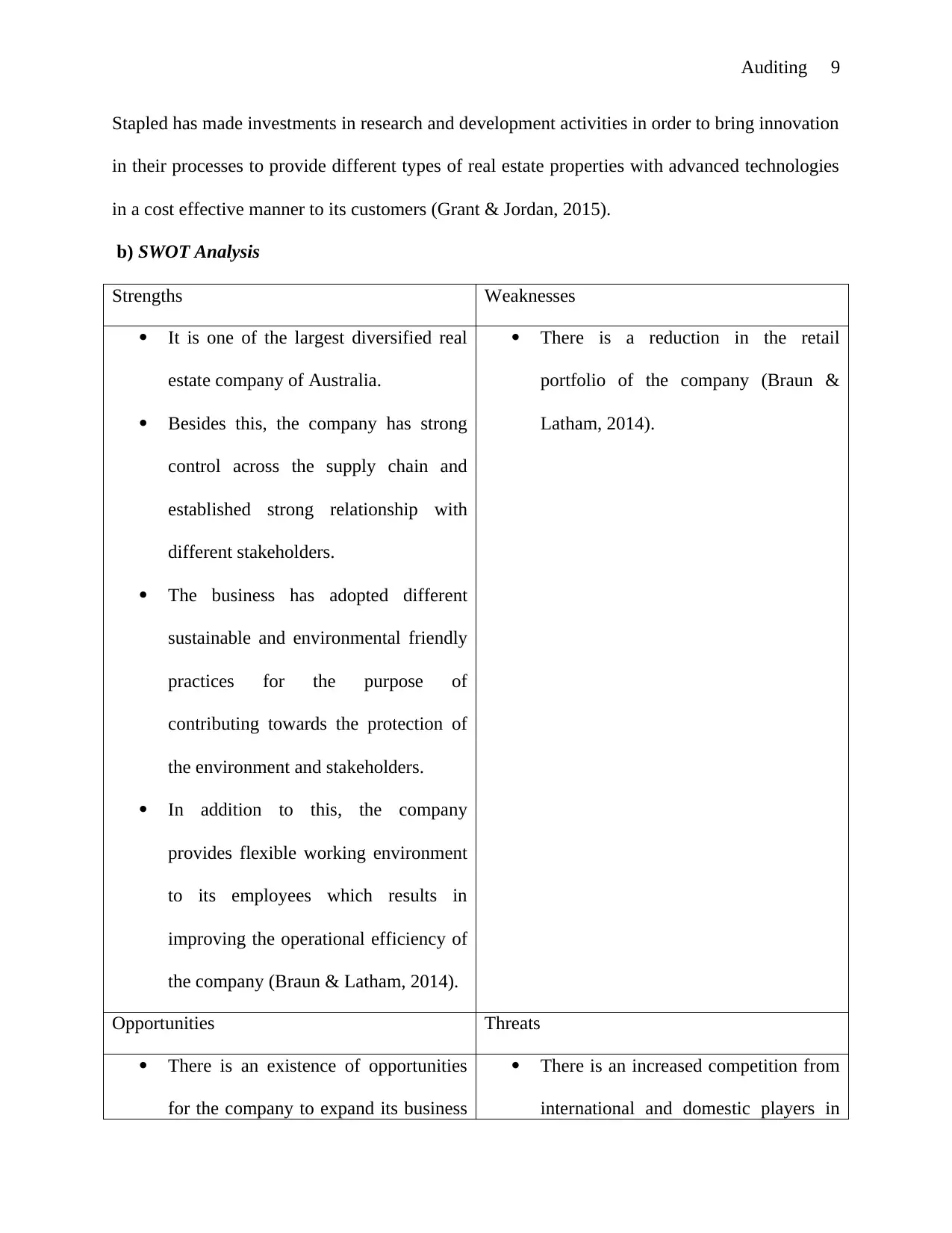
Auditing 9
Stapled has made investments in research and development activities in order to bring innovation
in their processes to provide different types of real estate properties with advanced technologies
in a cost effective manner to its customers (Grant & Jordan, 2015).
b) SWOT Analysis
Strengths Weaknesses
It is one of the largest diversified real
estate company of Australia.
Besides this, the company has strong
control across the supply chain and
established strong relationship with
different stakeholders.
The business has adopted different
sustainable and environmental friendly
practices for the purpose of
contributing towards the protection of
the environment and stakeholders.
In addition to this, the company
provides flexible working environment
to its employees which results in
improving the operational efficiency of
the company (Braun & Latham, 2014).
There is a reduction in the retail
portfolio of the company (Braun &
Latham, 2014).
Opportunities Threats
There is an existence of opportunities
for the company to expand its business
There is an increased competition from
international and domestic players in
Stapled has made investments in research and development activities in order to bring innovation
in their processes to provide different types of real estate properties with advanced technologies
in a cost effective manner to its customers (Grant & Jordan, 2015).
b) SWOT Analysis
Strengths Weaknesses
It is one of the largest diversified real
estate company of Australia.
Besides this, the company has strong
control across the supply chain and
established strong relationship with
different stakeholders.
The business has adopted different
sustainable and environmental friendly
practices for the purpose of
contributing towards the protection of
the environment and stakeholders.
In addition to this, the company
provides flexible working environment
to its employees which results in
improving the operational efficiency of
the company (Braun & Latham, 2014).
There is a reduction in the retail
portfolio of the company (Braun &
Latham, 2014).
Opportunities Threats
There is an existence of opportunities
for the company to expand its business
There is an increased competition from
international and domestic players in
⊘ This is a preview!⊘
Do you want full access?
Subscribe today to unlock all pages.

Trusted by 1+ million students worldwide

Auditing 10
in the retail properties sector.
Besides this, the company can avail
new market opportunities through
digital revolution (Fleisher &
Bensoussan, 2015).
the market.
Increase in the affordable housing
properties results in increasing a
challenge for the company in Australia
(Fleisher & Bensoussan, 2015).
c) Porter’s Five Forces Model
Threat from new entrants:
There is a presence of different business opportunities in the real estate business which attracts
large number of investors which results in increasing the number of new companies in the
industry which poses threat to the sustenance of Stockland Stapled company (Hamilton &
Webster, 2015).
Bargaining power of suppliers
The bargaining power of suppliers in the real estate industry is high which reflects that suppliers
can supply to different companies which may affect the profit margins of Stockland Stapled as it
might be possible that the company find difficulty in procuring materials from suppliers at low
cost (Humphries & Gibbs, 2015).
Bargaining Power of Buyers:
There is a high bargaining power of buyers in the industry which shows that the buyers prefer to
buy those properties which are offered at low prices. This has a significant adverse impact on the
profitability of Stockland Stapled company (Rao & Klein, 2015).
Threat from substitute products
in the retail properties sector.
Besides this, the company can avail
new market opportunities through
digital revolution (Fleisher &
Bensoussan, 2015).
the market.
Increase in the affordable housing
properties results in increasing a
challenge for the company in Australia
(Fleisher & Bensoussan, 2015).
c) Porter’s Five Forces Model
Threat from new entrants:
There is a presence of different business opportunities in the real estate business which attracts
large number of investors which results in increasing the number of new companies in the
industry which poses threat to the sustenance of Stockland Stapled company (Hamilton &
Webster, 2015).
Bargaining power of suppliers
The bargaining power of suppliers in the real estate industry is high which reflects that suppliers
can supply to different companies which may affect the profit margins of Stockland Stapled as it
might be possible that the company find difficulty in procuring materials from suppliers at low
cost (Humphries & Gibbs, 2015).
Bargaining Power of Buyers:
There is a high bargaining power of buyers in the industry which shows that the buyers prefer to
buy those properties which are offered at low prices. This has a significant adverse impact on the
profitability of Stockland Stapled company (Rao & Klein, 2015).
Threat from substitute products
Paraphrase This Document
Need a fresh take? Get an instant paraphrase of this document with our AI Paraphraser
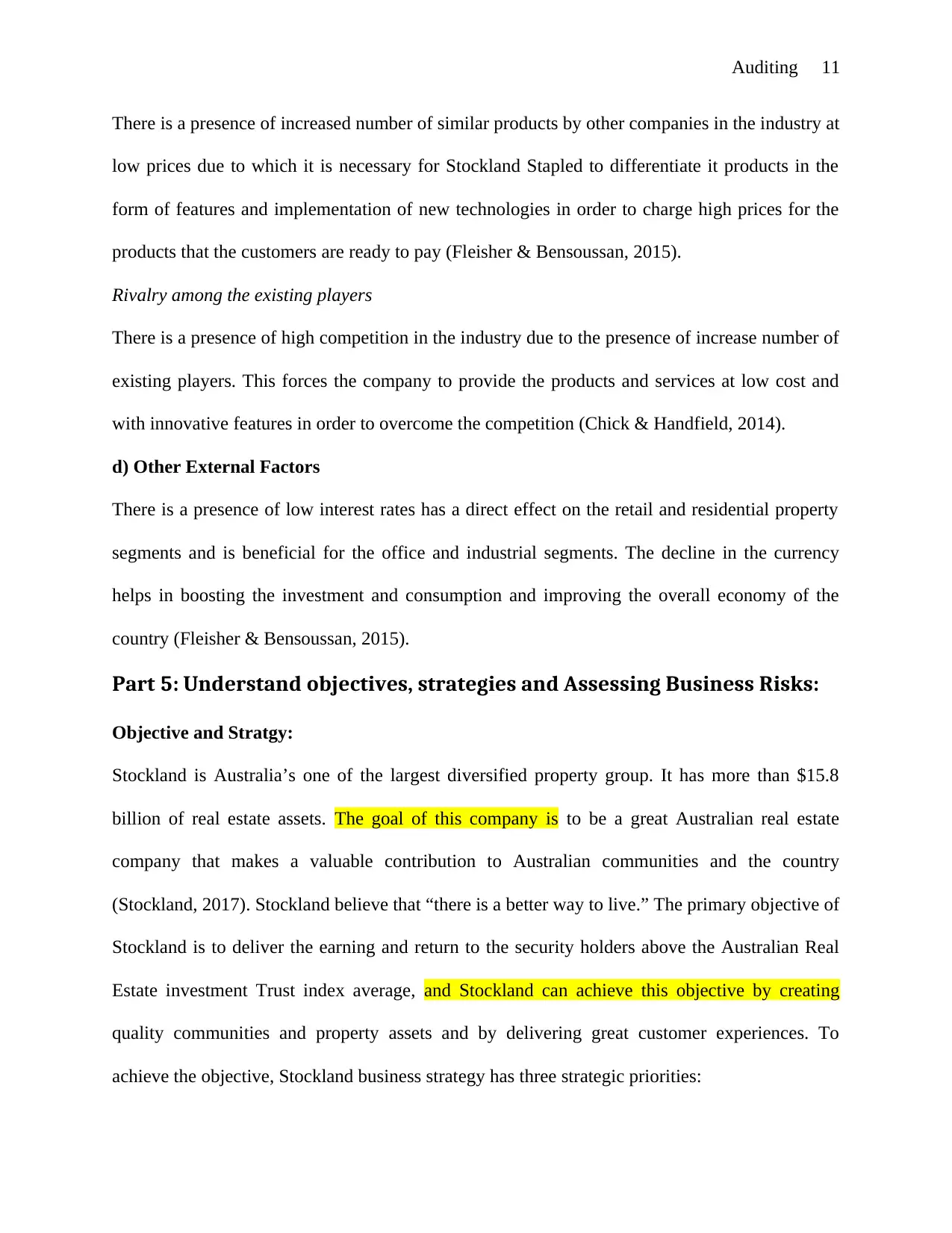
Auditing 11
There is a presence of increased number of similar products by other companies in the industry at
low prices due to which it is necessary for Stockland Stapled to differentiate it products in the
form of features and implementation of new technologies in order to charge high prices for the
products that the customers are ready to pay (Fleisher & Bensoussan, 2015).
Rivalry among the existing players
There is a presence of high competition in the industry due to the presence of increase number of
existing players. This forces the company to provide the products and services at low cost and
with innovative features in order to overcome the competition (Chick & Handfield, 2014).
d) Other External Factors
There is a presence of low interest rates has a direct effect on the retail and residential property
segments and is beneficial for the office and industrial segments. The decline in the currency
helps in boosting the investment and consumption and improving the overall economy of the
country (Fleisher & Bensoussan, 2015).
Part 5: Understand objectives, strategies and Assessing Business Risks:
Objective and Stratgy:
Stockland is Australia’s one of the largest diversified property group. It has more than $15.8
billion of real estate assets. The goal of this company is to be a great Australian real estate
company that makes a valuable contribution to Australian communities and the country
(Stockland, 2017). Stockland believe that “there is a better way to live.” The primary objective of
Stockland is to deliver the earning and return to the security holders above the Australian Real
Estate investment Trust index average, and Stockland can achieve this objective by creating
quality communities and property assets and by delivering great customer experiences. To
achieve the objective, Stockland business strategy has three strategic priorities:
There is a presence of increased number of similar products by other companies in the industry at
low prices due to which it is necessary for Stockland Stapled to differentiate it products in the
form of features and implementation of new technologies in order to charge high prices for the
products that the customers are ready to pay (Fleisher & Bensoussan, 2015).
Rivalry among the existing players
There is a presence of high competition in the industry due to the presence of increase number of
existing players. This forces the company to provide the products and services at low cost and
with innovative features in order to overcome the competition (Chick & Handfield, 2014).
d) Other External Factors
There is a presence of low interest rates has a direct effect on the retail and residential property
segments and is beneficial for the office and industrial segments. The decline in the currency
helps in boosting the investment and consumption and improving the overall economy of the
country (Fleisher & Bensoussan, 2015).
Part 5: Understand objectives, strategies and Assessing Business Risks:
Objective and Stratgy:
Stockland is Australia’s one of the largest diversified property group. It has more than $15.8
billion of real estate assets. The goal of this company is to be a great Australian real estate
company that makes a valuable contribution to Australian communities and the country
(Stockland, 2017). Stockland believe that “there is a better way to live.” The primary objective of
Stockland is to deliver the earning and return to the security holders above the Australian Real
Estate investment Trust index average, and Stockland can achieve this objective by creating
quality communities and property assets and by delivering great customer experiences. To
achieve the objective, Stockland business strategy has three strategic priorities:

Auditing 12
Grow assets return and customer base: This strategy is based on driving returns in their core
businesses.
Capital Strength: According to this strategy Stockland actively maintaining its balance
sheet’s diverse funding sources and efficient cost of capital (Stockland, 2017).
Operational Excellence: This strategy includes improvement in the ways the company
operate across the group to enhance the efficiencies and effectiveness of the employees and
the overall performance.
Business Risks:
There are many business risks that can be experience by any company like Stockland. If
Stockland develops its business than there is a risk that existing employees can work with new
technology or not. If Stockland develops its business it means the infrastructure and the standard
of the technology will increase so this can be a problem for the existing employees. Another risk
for Stockland is introduction of new products and services; this is also a risk for business because
suddenly increased in production and the procedure of new product production can be a problem
for business because the employees will not able to understand the procedure and the description
of the product (Berkowitz, et al., 2011). Use of IT in businesses can be a risk because to operate
the technology business needs expertise. Using IT in business is beneficial but it can be happen
that the system and processes can be incompatible. Along with this, regulatory requirements are
also a part of risk for businesses. Regulatory risk is the risk that a change in law and regulation
will affect the business and market. These changes in law and regulation made by government
and these changes can increase the cost of operating a business and can change the competitive
landscape.
Grow assets return and customer base: This strategy is based on driving returns in their core
businesses.
Capital Strength: According to this strategy Stockland actively maintaining its balance
sheet’s diverse funding sources and efficient cost of capital (Stockland, 2017).
Operational Excellence: This strategy includes improvement in the ways the company
operate across the group to enhance the efficiencies and effectiveness of the employees and
the overall performance.
Business Risks:
There are many business risks that can be experience by any company like Stockland. If
Stockland develops its business than there is a risk that existing employees can work with new
technology or not. If Stockland develops its business it means the infrastructure and the standard
of the technology will increase so this can be a problem for the existing employees. Another risk
for Stockland is introduction of new products and services; this is also a risk for business because
suddenly increased in production and the procedure of new product production can be a problem
for business because the employees will not able to understand the procedure and the description
of the product (Berkowitz, et al., 2011). Use of IT in businesses can be a risk because to operate
the technology business needs expertise. Using IT in business is beneficial but it can be happen
that the system and processes can be incompatible. Along with this, regulatory requirements are
also a part of risk for businesses. Regulatory risk is the risk that a change in law and regulation
will affect the business and market. These changes in law and regulation made by government
and these changes can increase the cost of operating a business and can change the competitive
landscape.
⊘ This is a preview!⊘
Do you want full access?
Subscribe today to unlock all pages.

Trusted by 1+ million students worldwide
1 out of 17
Related Documents
Your All-in-One AI-Powered Toolkit for Academic Success.
+13062052269
info@desklib.com
Available 24*7 on WhatsApp / Email
![[object Object]](/_next/static/media/star-bottom.7253800d.svg)
Unlock your academic potential
Copyright © 2020–2025 A2Z Services. All Rights Reserved. Developed and managed by ZUCOL.





